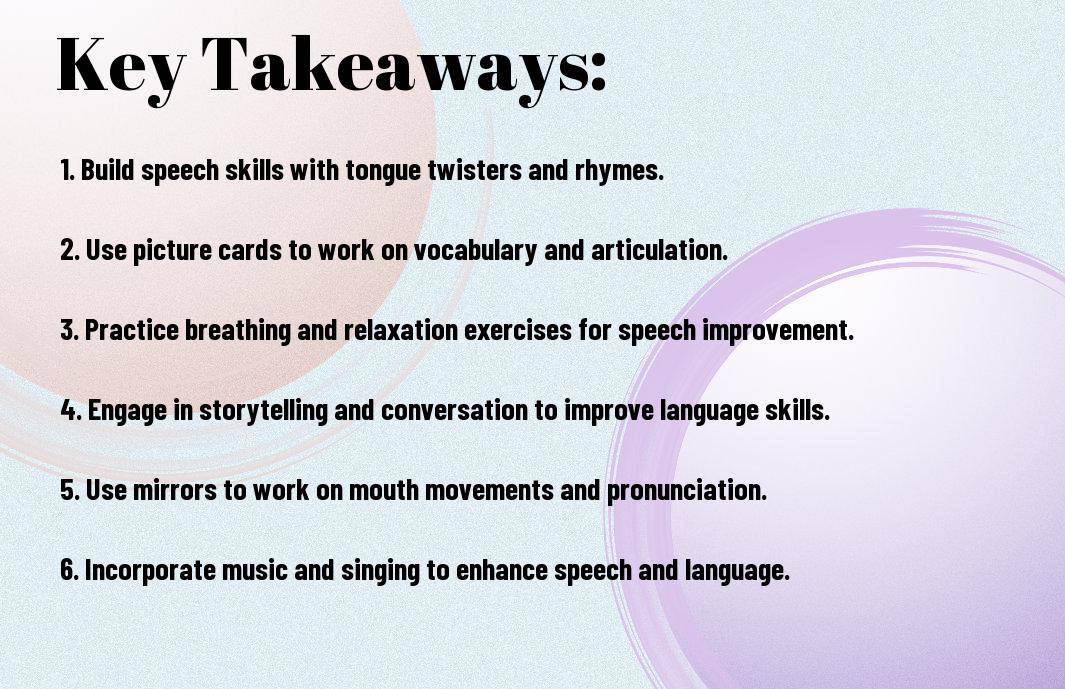Tachyphasia, also known as rapid speech, is a common issue for individuals with speech disorders. It can create significant challenges in communication and daily interactions. In this blog post, we will discuss effective speech therapy techniques that you can practice at home to improve speech fluency and clarity. These techniques have been proven to be beneficial in enhancing speech production and articulation, and can be easily incorporated into your daily routine. By dedicating time to these exercises, individuals can experience significant improvement in their speech abilities. We will cover a range of techniques, including breathing exercises, tongue twisters, and vocal warm-ups, all of which can be easily implemented in the comfort of your own home. By consistently practicing these techniques, you can make a positive impact on your speech therapy journey.
Key Takeaways:
- Consistency is key: Practice speech therapy techniques regularly at home to see improvement in communication skills.
- Use visual aids: Incorporate visual aids such as flashcards and picture books to enhance speech therapy exercises.
- Seek professional guidance: While practising at home can be beneficial, it’s important to consult a speech therapist for tailored guidance and support.


Understanding Speech Disorders
Speech disorders can affect a person’s ability to produce sound or speak fluently. These disorders can be caused by a variety of factors, including neurological conditions, developmental delays, or physical impairments. Understanding the different types of speech and language disorders is crucial for identifying the most effective speech therapy techniques.
Types of Speech and Language Disorders
There are several types of speech and language disorders, each with its own set of challenges and symptoms. These include articulation disorders, fluency disorders, resonance disorders, and language disorders. It’s important to note that some individuals may experience a combination of these disorders, which can impact their ability to communicate effectively. Assume that an individual may have more than one type of speech disorder and tailor therapy techniques accordingly.
| Disorder Type | Symptoms |
|---|---|
| Articulation Disorders | Difficulty pronouncing certain sounds or words |
| Fluency Disorders | Repetition or prolongation of sounds, words, or phrases |
| Resonance Disorders | Nasal or hoarse voice quality |
| Language Disorders | Difficulty understanding or expressing thoughts through language |
How Speech Therapy Can Help
Speech therapy can play a crucial role in improving communication skills and overall quality of life for individuals with speech and language disorders. Therapists use a variety of techniques to target specific speech difficulties and improve fluency, articulation, and language comprehension. Through consistent practice and guidance, individuals can make significant progress in their ability to communicate effectively.
Furthermore, speech therapy can also help individuals develop confidence in their communication abilities and positively impact their social interactions. It provides a structured and supportive environment for individuals to work on their speech goals and overcome any challenges they may face.
Core Speech Therapy Techniques
Articulation Exercises
Articulation exercises are critical in improving speech clarity and precision. These exercises focus on strengthening the muscles used in speech production, as well as improving coordination and control of speech movements. Examples of articulation exercises include tongue twisters, repeating sounds or syllables, and exaggerating mouth movements to visually see and feel the correct placement of articulators. These exercises are designed to help individuals overcome speech sound disorders, such as mispronunciation or difficulty producing certain sounds.
Language Intervention Activities
Language intervention activities are designed to improve overall language skills, including vocabulary, grammar, and comprehension. These activities can involve reading, storytelling, playing word games, and engaging in conversation. They are tailored to address specific language difficulties, such as expressive or receptive language disorders, and can be adapted to suit the individual’s age, interests, and abilities. Language intervention activities not only target speech and language development, but also promote social interaction and cognitive functioning.
Language intervention activities are a crucial component of speech therapy, as they provide a holistic approach to improving communication abilities. By incorporating a variety of stimulating and interactive activities, individuals are more motivated and engaged in their therapy, leading to more effective outcomes. These activities can be easily incorporated into daily routines, allowing for consistent and meaningful practice in a familiar environment.

Implementing a Home-Based Speech Therapy Plan
Creating a Supportive Environment
Creating a supportive environment is vital for the success of any home-based speech therapy plan. Ensure that the space is free from distractions and conducive to learning. This means finding a quiet area in the home where the individual can focus without interruption. Remove any potential distractions such as electronic devices or loud noises that may hinder the therapy sessions. Additionally, encourage open communication and provide positive reinforcement to create a safe and welcoming atmosphere for the individual.
Establishing a Routine and Setting Goals
Consistency is key in a home-based speech therapy plan. Establish a routine that includes regular therapy sessions to help the individual stay on track with their progress. Setting achievable goals is also important to keep the individual motivated and focused on their improvement. Work with the individual to set realistic targets that they can work towards, celebrating each milestone achieved.
In addition to regular therapy sessions, consider incorporating speech exercises into daily activities to reinforce learning and maximise the benefits of therapy. This will help the individual to continually practice their speech skills and integrate them into their everyday life.
Advanced Strategies and Tools
When it comes to advanced speech therapy techniques, there are several tools and strategies that can be utilised to further enhance speech development. These techniques are particularly beneficial for individuals who have already mastered the basics and are looking to challenge themselves further. Here are some advanced strategies and tools to consider:
- Utilising advanced speech therapy apps and software to practice pronunciation and articulation.
- Engaging in advanced vocal exercises to improve voice projection and intonation.
- Exploring alternative communication methods such as sign language or augmentative and alternative communication (AAC) devices.
- Seeking guidance from a speech therapist for tailored advanced techniques and tools.
For more detailed tips and techniques, you can also refer to What are some tips for practicing speech therapy exercises at home.
Using Technology and Apps in Speech Therapy
Incorporating technology and speech therapy apps into home practice can greatly benefit individuals working on their speech skills. There are a wide range of apps and software available that are specifically designed to target speech and language development. These tools can provide interactive exercises, visual aids, and instant feedback to help individuals improve their communication skills.
Incorporating Play and Daily Activities
Engaging in play and incorporating speech therapy techniques into daily activities can make speech practice more enjoyable and natural. Through play, individuals can work on their speech and language skills in a relaxed and comfortable environment. Simple activities such as storytelling, singing, and games can be integrated with speech exercises to make learning more engaging.
By integrating speech therapy techniques into everyday activities, individuals can reinforce their skills in a fun and practical way. This approach also helps to promote consistency and ensure that practice becomes a regular part of daily routines, leading to more effective results over time.
Speech Therapy Techniques You Can Practice at Home
In conclusion, implementing speech therapy techniques at home can be highly beneficial for individuals who require extra assistance in improving their communication skills. By utilising strategies such as the ones outlined in the article on 15 Speech Therapy Strategies for Parents to Use at Home, individuals can enjoy the convenience and comfort of practising these exercises in the familiar environment of their home. By regular practice and consistency, individuals can make significant progress and work towards achieving their communication goals. It is important to seek guidance from a qualified speech therapist to tailor these techniques to the specific needs of the individual. With dedication and support, individuals can effectively enhance their communication skills and build confidence in their ability to express themselves.
Speech Therapy Techniques You Can Practice at Home FAQ
Q: What is speech therapy?
A: Speech therapy is a treatment for speech and language disorders. It can help individuals improve their communication skills and overcome speech challenges.
Q: What are some speech therapy techniques that can be practised at home?
A: Some speech therapy techniques that can be practised at home include breathing exercises, articulation drills, and tongue strengthening exercises.
Q: How can breathing exercises help with speech therapy?
A: Breathing exercises can help improve breath support for speech production and enhance vocal quality and control.
Q: What are articulation drills and how can they benefit speech therapy?
A: Articulation drills are exercises that focus on improving the coordination and movements of the speech organs. Practising these drills can help enhance speech clarity and accuracy.
Q: How do tongue strengthening exercises contribute to speech therapy?
A: Tongue strengthening exercises help improve tongue muscle strength and coordination, which are essential for speech production and articulation.
Q: Are there any resources or tools that can assist with home-based speech therapy?
A: Yes, there are various resources and tools available, such as speech therapy apps, online exercises, and instructional videos, which can support home-based speech therapy practice.
Q: What should be considered when practising speech therapy techniques at home?
A: It is important to seek guidance from a qualified speech therapist to ensure that the techniques are being practised correctly and to monitor progress. Consistency and patience are also key factors for successful home-based speech therapy practice.







